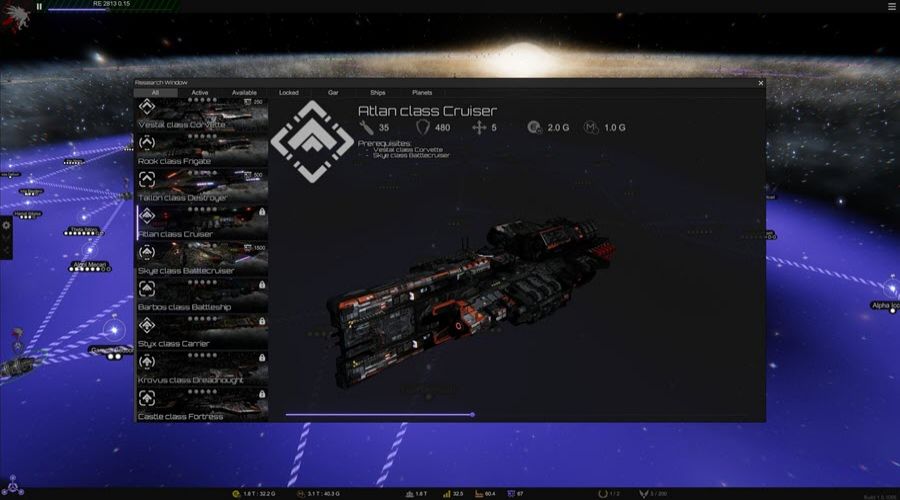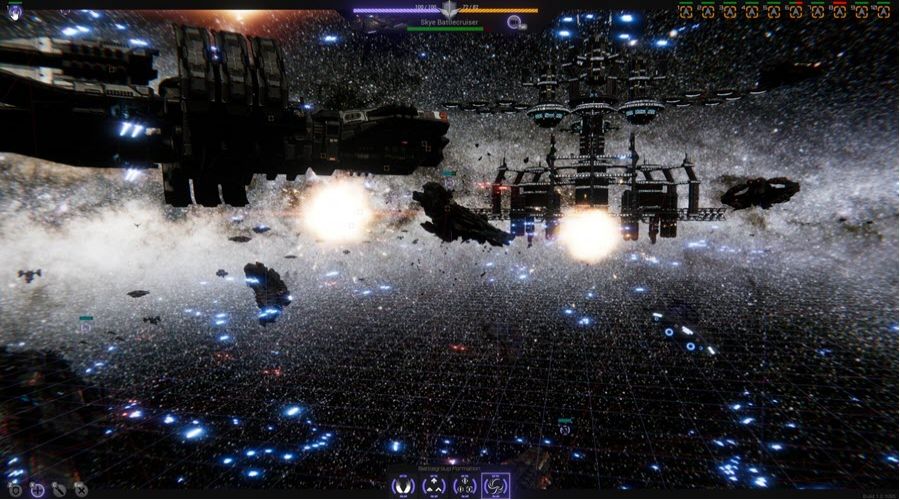Heathen Engineering's Terran

Review
Once the game loads you’ll be taken to the main menu screen; here in the left top corner you’ll find Continue (if already have a saved game), New Campaign, Load Campaign, Skirmish, Options, Credits and Exit. On the top right corner in the drop-down box there’s User Guide, Video Walkthrough, Community Hub, Heathen Support, Translation Tool. There are also some Audio Controls (Master, Music, Interface and Environment volume sliders), these can also be found in the game’s options.
Upon starting a new campaign you’ll be taken to a screen where you’ll be able to customise your game profile. Here you’ll be able to create a two-tier logo from various patterns and icons, changing colours to your liking. Further down the screen is Gar Design. There are three types of Gars to choose from: Valkyrie, Theseus and Fallen, each with its own abilities (five each in total). For example, The Fallen has Doom (which can instantly destroy a target), The Theseus has Children of Poseidon (which can terraform a planet in to an ocean world), and Valkyrie has Ride of the Valkyr (which can deploy the Valkyr and convert a system to your way.
Gars work in addition to your organisation and improve their attributes. They are ornate, huge and powerful warships, which can influence a star system. If you lose your Gar at any time, then it’s Adios Amigos! Choose your Gar wisely as you cannot change it once you start a game.

Next you can give your organisation a name and choose the type of organisation you’d like to play as. There are three options to choose from: Corporation, Government and Armada. Each of these has their own benefits; Corporation gives you earlier access to economic and industrial-based attributes, the Government gives early access to population and expansion-based attributes, while Armada give you early access to advanced warship designs and fleet-based attributes. You can still unlock the attributes upgrades of the other organisations, although it may take some time to do so.
In the top right of the screen you can also adjust the ratio of planets in your galaxy. You can select the percentage of each type of planet using a slider, or you can use the random button to decide for you. You can also use the rest button next to the random button to reset back to default. The types of planets are Gas Giant, Ice, Molten, Ocean, Rock and Terrestrial, and just below these you can set the number of Opponents (AI Player Count).
After you’ve completed setting up and read a bit about the organisations and the goal of the game, you can hit the Start Game button and proceed into the game. While the game loads the galaxy, you’ll be shown some information on random things within the game, such as information on planets and ships etcetera, along with some tips on how to maybe defeat or improve upon a certain planet.
After hitting the Start Game button, you’ll be greeted with a window detailing your objective for the game along with the option to do the tutorial. There are two types of tutorial you can chose to go through, one being a Video Walkthrough which will drop you to desktop and then open You Tube. The other is Intro Tutorial, which will take you over the hub showing and detailing each part of the game and what it does. You can choose to Skip Tutorial should you wish, or if you’ve previously gone over it.
After declining or accepting the tutorial, you’ll have in front of you a small system with lots of bright points scattered around the screen. In this system you’ll spot your organisation’s name indicating that this is controlled by you; this is your home system. Close by will be your Gar; surrounding them is a blue hue, and around that it’s the blackness of space with many points of light, which could be other star systems. You can select a point of light and if it’s within the blue hue you’ll be given some information on that system. But to start with you’ll need to check out your home star system by selecting the star system indicated by a laurel. This will open a window detailing all the planets in that system; there are several different types of planets.
You’re not going to be able to take advantage of all the planets at first; you’ll need to do some research before being able to make use of any resources. To research anything you’ll need to bring up the research window, which can be done by clicking on the icon in the lower left-hand corner. Here you have five research tabs: Available, Gar, Ships, Planets and All. Researching anything can take quite a few months to complete; some research will be needed to unlock some planets and ships.
In the planet research you can also upgrade attributes to a planet; these attributes are Colony, Economy, Industry, Science and Terraform. Each planet can have their attributes upgraded five times, and after the fourth time you’ll have the option of Terraforming that planet. However, before you’re able to do so you’ll be required to research the terraforming ability on your Gar.
In order to collect resources and colonise planets etcetera, you’ll need to assign an outpost. Depending on the planet it will determine what it’s good for. Rocky planets aren’t good for much, molten or frozen can be ideal for industry, gas giants are best for science and terrestrial planets are good for colonising. You can add different outposts to planets, although if they aren’t very well-suited for that type of outpost, they may still bring in resources (albeit at a much lesser rate).
In the centre left of the screen you’ll see three icons, which are System, Fleet and Economic Administration. In system administration you’ll find information like population, trading posts, resources and contested systems. In fleet administration you’ll find any fleets, stations and citadels you currently have at your disposal. You can also create new fleets, stations and citadels here. Creating a fleet is simple - just click the button which opens a window, and here you’ll have all the ships you can create; however, you’ll need to unlock most of them through research. Once you’ve created a fleet you can send them wherever you want by selecting them and then right clicking on where you want to send them.
Creating a station will allow you to link near-by systems that you’re currently occupying. They only cover a certain area and you cannot overlap with another station. The citadel is a massive station which is attached to a star system; you start with one of these and they provide defence and insure influence on that system. You can create more citadels as you progress through the galaxy, but you’re only really allowed two of them. The more you have, the more they cost; you can, though, decommission a citadel should you wish to bring one further towards your frontline.
As it can take quite a while to research anything, you are able to speed up time, which is handy as I could only research one thing at a time (I could be doing something wrong). You can slow time down as well; to speed up, slow down or pause the passage of time you can use the slider in the top left-hand corner.
In the options you’ll find Language, Key Binds, Audio, Master, Music, Interface and Environment sliders. Display; AntiAliasing, Screen Space Reflections, Ambient Occlusion and Chromatic Aberration On/Off. Lighting Exposure - Map View, Lighting Exposure - Combat View, Saturation and Contrast sliders.
I found the text to be a little too small for me, which strained my eyes a bit, especially the Key Bindings in the options, (this is going to be sorted at some point in the future according to the developer). At first I was struggling playing the game, but after a while I started to get the gist of things and after spending many, many months researching the planets, and having made some outposts, I set of into the blackness of space expanding my territory.
Review written by Piston Smashed™ for Zeepond.com!
Positives
+ Steady game, plenty of space to cover+ Four to thirty AI opponents
+ Customisable logo’s
+ Achievements
+ Cards
Negatives
- Only able to research once thing at a time.- Fonts are too small (dev sorting this at some point)
Review Summary
Starting from a single star system, research planets, build outposts and terraform them for resources; construct huge fleets as you expand your empire across the galaxy.
Share this review!
Zeepond Rating: 7/10










Video
Game Categories
All Game Reviews (1352)Hardware Reviews (0)
Action (341)
Adventure (151)
Alpha Games (2)
Anime (5)
Board Games (3)
Casual (135)
First Person (19)
First Person Shooter (30)
Hardware (0)
Horror (38)
Massive Multiplayer Online (4)
Pixel Graphics (22)
Platformer (94)
Puzzles (64)
Racing (26)
Role Playing Game (61)
Simulation (53)
Sports (20)
Strategy (246)
Third Person (11)
Utility software (1)
Virtual Reality (22)

